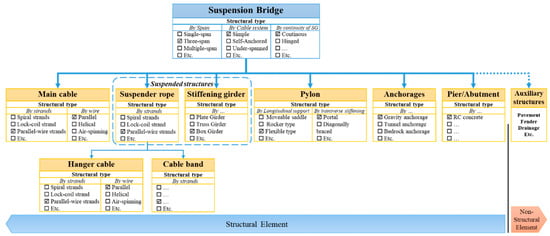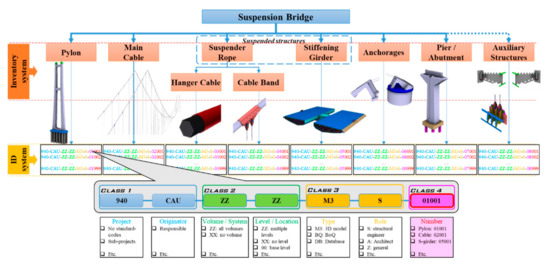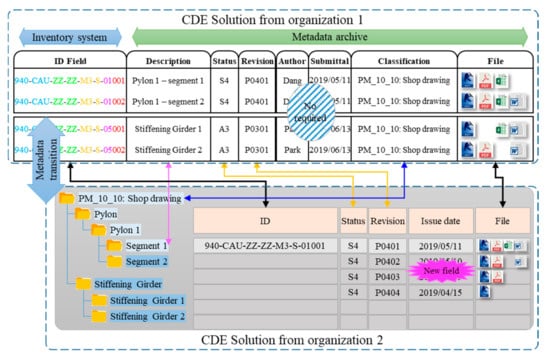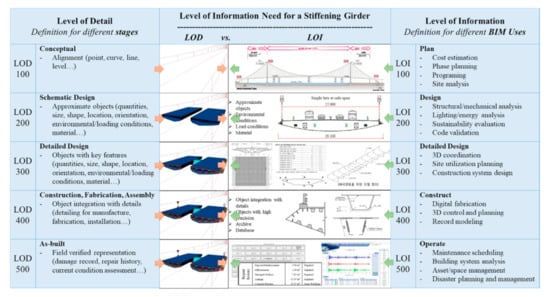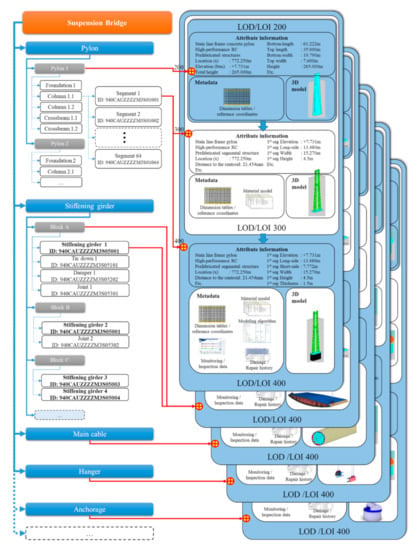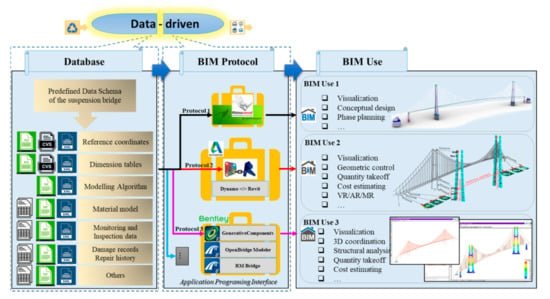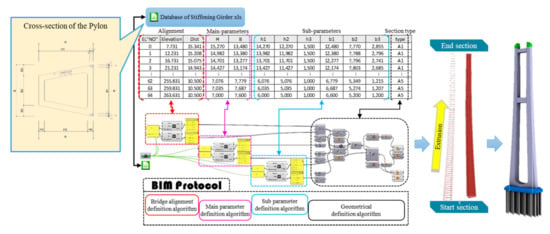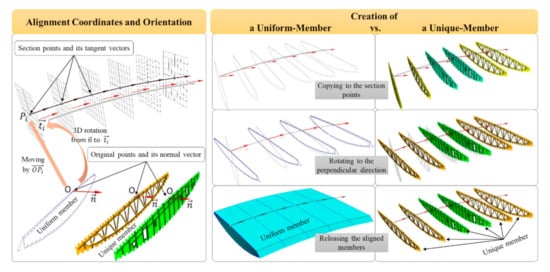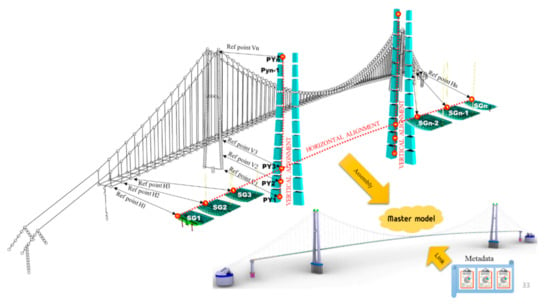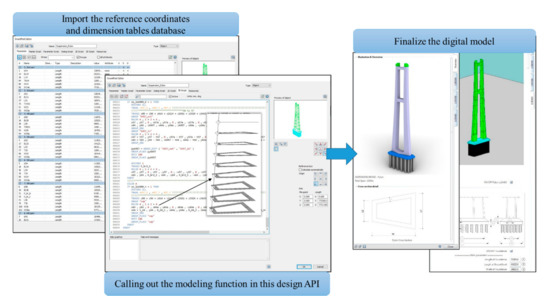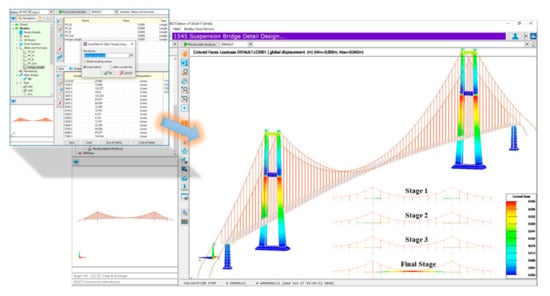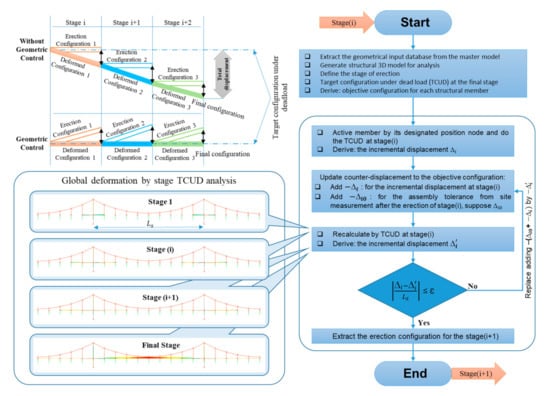Abstract
Long-span suspension bridges require accumulated design and construction technologies owing to challenging environmental conditions and complex engineering practices. Building information modeling (BIM) is a technique used to federate essential data on engineering knowledge regarding cable-supported bridges. In this study, a BIM-based master digital model that uses a data-driven design for multiple purposes is proposed. Information requirements and common data environments are defined considering international BIM standards. A digital inventory for a suspension bridge is created using individual algorithm-based models, and an alignment-based algorithm is used to systematize them and generate the entire bridge system. After assembling the geometrical model, metadata and various BIM applications are linked to create the federated master model, from which the mechanical model is derived for further stages. During the construction stage, the advantage of this digital model lies in its capability to perform efficient revisions and updates with respect to varying situations during the erection process. Stability analyses of the bridge system can be performed continuously at each erection step while considering the geometric control simulation. Furthermore, finite element analysis models for any individual structural member can be extracted from the master digital model, which is aimed at estimating the actual behavior of bridge members. In addition, a pilot master digital model was generated and applied to an existing suspension bridge; this model exhibited significant potential in terms of bridge data generation and manipulation.
1. Introduction
Cable-supported bridges, whose service life can exceed 100 years, represent the most significant investments in national transport networks. During its service life, there is a big challenge for bridge engineers in terms of maintaining the suspended structures in a safe condition; otherwise, it can cause many serious problems. For example, an unexpected disaster of bridge collapses leading to the lack of transport links can result in significant social problems, as suggested by the recent collapse of the Morandi bridge [1]. Moreover, the main cables in a suspended system are assessed based on the tension force they experience and their safety factors; however, a visual inspection is recommended only after a period of 30 years [2]. Recently, a methodology for evaluating the remaining service life of bridge cables was introduced [3]. New approaches for knowledge sharing necessitate learning from similar cases and avoiding such accidents. This varied knowledge, ranging from the first phase of bridge construction to the next 100 years, can then be utilized. The limitation of existing information storage and collection systems, which are operated by a few experts, is apparent.
It can be considerably difficult for engineers to determine appropriate structural systems where the following aspects are balanced: optimization of weight and cost, guaranteeing aerodynamic aspects during construction and service periods, and feasibility of construction [4]. Among the various types of bridges built worldwide, suspension bridges are considered superior in terms of aesthetics. Following the concept of a long-span bridge, the main advantage of suspension bridges is their ability to bridge considerably long spans, such as over deep water bodies where it is not possible, or significantly expensive, to build foundations for piers supporting the shorter spans of other types of bridges. However, the long spans of these bridges result in problems primarily associated with the construction process, aerodynamic stability, and the impact of self-weight on the static load of the bridge [4,5,6]. When engineers create an effective design that counters these problems, the potential of the design is abundant. However, in the absence of such an effective design, a significant risk of collapse exists, which must be considered.
The conducted comprehensive review and critical analysis of a total of 198 publications in terms of building information modeling for transportation infrastructure have presented the state of the art of BIM implementation in this field, including the overview of the BIM domains, BIM applications, data schemas, and BIM uses [7]. It shows that there was an improvement in BIM research and application development for transportation infrastructure in general, especially for highways and bridges. It also highlights the current status of research, the usage of emerging technologies, and significant research gaps that still need to be addressed. On the other hand, it summarizes the constraints and challenges facing the transportation industry, highlighted the significant need for interoperability and existing interoperability initiatives, and presented recommendations to support future research. Recently, bridge information modeling (BrIM) was proposed for the innovation of bridge construction processes from planning to operation. Bridge information modeling (BrIM) using open parametric objects was introduced in detail by the FHWA (Federal Highway Administration, which is sponsored by the U.S. Department of Transportation) [8]. They opened the data schema, named OpenBrIM Platform, which focuses on transforming bridge practice from paper delivery to digital delivery, developing digital BrIM standards, providing interoperability between many platforms and life-cycle stages, and maintaining software neutrality. Based on that open XML data, the user can freely adapt and develop their own BrIM model for a certain purpose, such as a bridge monitoring system [9].
The 3D geometrical models for existing bridge structures can be created in various ways depending on the capability and resource of the originator. The geometric representation comprising each structural member can be referred to as the IFC Bridge model, which aims to flexibly link geometric representations with semantic objects [10]. IFC schema can be learned and developed for the bridge information system by appropriate compiling IFC Bridge and IFC Infrastructure extensions [10]. On the other hand, recently the author of this paper and his research team have widely introduced the digital information models using the BIM technique for various types of bridges, such as cable-stayed bridge [11,12] and prestressed concrete bridge [13,14,15]. The alignment-based object-oriented design philosophy appears to be essential for the creation of a bridge information model. By applying a set of parameter definitions and appropriate algorithms, the entire bridge model can be realized without any discontinuity. The parametric design concept enables designers to alter any input factors of the model in order to match the target requirements. Moreover, during its lifecycle, the digital bridge model significantly helps engineers in managing the flow of information for multiple purposes. The interoperability of the design platform allows collaborative work among various stakeholders and stages of the project.
Cable modeling for suspension bridges is a major challenge for engineers. There is no unique undeformed configuration for cable structures in the stress-free state; this is because any applied tension generates lateral stiffness in the cable. Therefore, only the deformed shape of a cable structure under dead loads, which is predetermined at the design stage, is similar to the framed structures. The undeformed configuration of a frame structure is predetermined during the design process based on functional specifications and the experience of engineers. Basic analysis tools that are based on predefined undeformed configurations can be easily used to measure the displacement field under dead loads because framed structures possess an initial rigidity that is independent of the applied load. However, a specific undeformed configuration for the equilibrium state of a cable structure under a dead load has not been reported thus far. This is because the lateral rigidity of a cable, caused by the applied tension, can be considered as a distinctive mechanical property for general cable structures. Owing to its self-weight, a cable is loaded even without any externally applied loads; hence, sufficient tension should be applied to the wire to counter the self-weight in order to target the desired configuration [16,17,18]. The concept of an elastic catenary cable element has been widely introduced for the main cables of suspension bridges [19].
Owing to the existence of an extensive range of variables, including construction methods, temporary supports, and alteration loads, geometric control for suspension bridges is always a difficult task. Moreover, for the main cable, geometrically nonlinear effects and multiple tension loads should be considered. During the construction stage of a suspension bridge, the cable profile continually changes according to the load, leading to a change in the specific geometrical configuration of other structures such as the suspended structure and the stiffening girder. Therefore, geometric control simulations should be implemented during the construction phase to ensure that the target configuration is satisfied after the erection of the bridge [20,21]. In this regard, a master digital bridge model is necessary; this model should be capable of extracting the suggested target configuration for each sub-process and continuously update the changes during the erection procedure in a timely manner in order to manage the specific geometrical configuration of each member.
To address the abovementioned complexities associated with suspension bridges, a design strategy with multiple goals is required. However, there is the fact that the commercial BIM solution bundles often direct users towards a specific goal. For example, commercial BIM design models cannot be used for maintenance purposes because they lack real-behavior information for the structure. In this regard, the concept of using a digital twin model is suggested [14] in which different single-purpose BIM models such as digital-twin, reality-twin, and mechanical-twin are federated into one unique master model. Hence, the engineer can handle more aspects not only of the design information but also damage condition, deterioration assessment, and service performance status of the structures. However, the limitation of using a federated model lies in its concept itself, because each twin is a model-based entity, so the engineer’s capability in terms of mapping the models or overlapping the appropriate structures will decide the accuracy of the federating process. On the other hand, suspension bridge projects are increasingly become bigger and more complicated, requiring more information but less time for design revisions; thus, more attention must be paid to the way in which information is handled. Therefore, this paper proposes a new concept for the creation of a master digital model based on and backed by data. The data schema for long-span bridges is not new and can be learned from engineers’ experience as well as referred from recent neutral open-standard models. However, the way to manipulate those data to form the database for the master model is a new challenge for the engineers. The master digital model is developed from one source of information, but the model is driven by different BIM protocols to achieve multiple purposes. In another word, the state of the art for a new master digital model lies in the way to implement the information, which is so-called data-driven design.
A so-called data-driven design is backed by data and helps users understand the target audience; it proves that the designer is on the right track. Recently, data-driven designs have been presented through a few early successful applications in planning and design projects. In particular, these designs enable engineers to modify and refine early prototypes in an iterative manner based on the simulated design outputs and functionality while constantly gathering project data for future usage. Thus, the engineer would need to formulate the procedures for link design, fabrication, construction, and operation. To address this, an interoperability platform that allows the exchange of models between programs should be considered [22]. Data-driven design nowadays is widely introduced as a “vehicle” for BIM education and sustainability [23]. Especially for building structure, several implementations of this design concept to create the information model for different purposes are proposed [24,25]. Moreover, for the infrastructure industry, data-driven engineering based on digital models requires a clear definition of a master digital model. This study deals with the information requirements of suspension bridge projects in terms of the design, analysis, and construction. Based on the as-built records of a suspension bridge, the digital inventory of each model and its master model are proposed. Additionally, model uses are presented as a pilot application of the model.
2. Data Schema
In any circumstance, when creating a BIM model for a certain purpose or for multiple purposes, the originator should clearly define a data schema for what he will create. The specific kind of information and how the information can be exchanged are very important. Aiming to generate only the needed information helps the engineer to save his effort and resources since the bridge information model consists of thousands of information pieces. In the early stage of a bridge project, an ideal data schema is therefore the first task for engineers. Based on that, the systematic bridge information system on later can be oriented and easily generated without any redundancies or reworks. Following the concepts of object-based modeling for typical BIM projects, all structural members of the suspension bridge are categorized into an inventory system according to their role in the entire bridge system. BIM tools might generate them separately, then assemble them by bridge alignments to form the master model of the bridge. Metadata can be linked to each structure by the corresponding element ID and stored in the common data environment (CDE).
2.1. Inventory System and Code System
According to the design conditions, the primary criteria and features of structural members can be formed into a systematic data schema. These relative values help engineers in classifying appropriate structural types and create a premise for managing bridge geometry as well as the subsequent structural diagram. After determining the desired bridge, such as three-span or multiple-span and gravity-anchored or self-anchored bridges, engineers can further classify the structure and orient the primary parameters of each structural member. Figure 1 shows an example of the structural classification of a general suspension bridge.
Using the aforementioned structural type classification of bridges, the bridge inventory system can be created. Each structural member is classified into a category in the inventory system according to its functions or services within the bridge system. It may typically be inventoried as a superstructure (such as slabs, stiffening girders, cables, and expansion joints) or as a substructure (such as bridge piers, abutments, and bearings). It should be noted that to pre-define the characteristics of each category, the structural elements should either have similar features and properties in one category or be further categorized into specific hierarchical categories. As a 3D information model is defined separately following the concept of the object-based specification. For this purpose, each structural member in an inventory system’s category must be assigned a particular identification (ID). The final information model is created by assembling the particular IDs of all the members obtained using their orientation data, including the coordinates and information constraints. In this regard, a detailed code system, i.e., a naming convention for each structural member, should be adopted. Following ISO 19650, the identification of information containers within a common data environment was proposed [26,27].
For each structural member, the identification consists of four classes (Figure 2). The first class includes general information regarding the “project” identifier and the “originator” of the information. With the initiation of a project, a single and independent common project identifier name is formed, which should be recognizably distinct from any individual project of any organization joining the project; otherwise, it should be defined as a sub-project. In addition, these joint organizations need an identifier name, which is included in each structural member ID to identify the individual responsible for producing this member information. The second class consists of information regarding the physical scope of each structure. The “Volume/system” identifier helps engineers in orienting the development of structural members in the horizontal direction, while the “Level/location” identifier helps assess the elevation of a member. The third class defines the purpose of the structure; the “Type” identifier should be defined for each type of information in order to orient the type of information that will be contained within the member. The “Role” identifier denotes the scope of the project assigned to an organization. The last class comprises a detailed code; it is divided into two fields: one that identifies the name of the structure (such as “01” for pylon and “02” for main cable) and another that identifies the exact member (such as “01001” for the left pylon and “01002” for the right pylon.) In each field, the detailed code should be a sequential number, similar to a series of structural members.
2.2. Common Data Environment and Metadata Management
To manage the collaborative production of bridge information, a CDE needs to be implemented, using which engineers can easily access allowed information to undertake their functions. Currently, with the advancements in the information technology industry, the CDE can be implemented in several ways through a variety of solutions and tools. Most importantly, detailed concepts and principles regarding the CDE solution and workflow must be clearly defined in accordance with a unique standard or certain guidelines. The CDE workflow concept is a closed loop involving the creation and exchange of information. First, all “work in progress” information is created and developed by the originator or task team; this information is not visible to or accessible by anyone else. The originator reviews and checks this information until it is approved for sharing with other appropriate task teams and delivery teams or with the appointing party. After the peer-reviewing and authorizing procedures, the information is published and authorized for use in further tasks such as detailed design, construction, or asset management. To manage the metadata through a CDE solution, each piece of information is assigned a status, revision, responsible person, submittal date, classification, and description. Through this process of metadata management, the quality assurance check can be undertaken. Each task team has to check every related information container whether it is in accordance with all the requirements or standards on methods and procedures of the project’s information production; otherwise, the task team has to reject those unassured information containers and feedback to the originator for correction requirements. Because a project is a process of collaborative work among many organizations, a compliant implementation plan in terms of information creation can enable the development of a federated information model. Hence, any issues or clashes in the information model should be identified during the production of information rather than after the delivery of information.
In terms of the object-based principle of information modeling, each structural member consists of two characteristics: “attribute information” and “archive metadata”. The “attribute information” characteristic, which includes some non-numerical information, is used to define the member ID, as explained in the previous section. It is a type of “active” information in the CDE and includes details on all general physical properties, such as the structure type, geometric shape, nominal size, material property, orientation information (including the position and restriction), and roles of the element in the entire structure system. In addition, the estimation of quantity/cost is necessary. This active information piece is frequently used during the production and delivery of information and during project implementation by all the organizations involved in the project. In contrast, the “archive metadata” characteristic in the CDE is a type of “inactive” information; this implies that only specific joined organizations or people are assigned to manage and undertake it. Only the most related organizations or engineers are granted access to this information.
From the production of information and during the bridge lifecycle, the metadata archive is continuously obtained and linked to the information system through the individual IDs of each structural member, including the shop-drawing documents, inspection and maintenance records, and classification and description for all the related information of each structural member. This need for metadata necessitates the creation of a procedure using which metadata can be transferred among the CDE solutions in case multiple CDE solutions are used among the organizations. These CDE solutions must collaborate efficiently while the information is being developed and exchanged as a part of the CDE workflow. If they do not interface with one another perfectly, the automated transfer of metadata is impossible. In this regard, a standard exchange protocol needs to be considered. Moreover, the format of information exchange and data-drop delivery needs to be considered to ensure that the metadata are computer-readable and easy to manage from any organization. Therefore, the metadata should be stored in primitive file formats such as .doc/.pdf/.txt for the text data, .xls/.cvs for the spreadsheet data, and .dxf/.fbx for the 3D model data. Figure 3 shows an example of a transition of metadata when more than one CDE solution is applied in a collaborative project.
2.3. Level of Information Need
Following the British Standard (ISO 19650), the level of development, including the level of detail and the level of information, is now collectively referred to as “level of information need”. The smart model of a suspension bridge comprises a large amount of information. To save resources during the information production task, a critical challenge arises in terms of managing the level of development of the design model. Depending on the various applications of BIM during the different stages of the bridge life cycle, the level of detail (LOD) and level of information (LOI) should be reasonably maintained. The LOD, which relates to the graphical content of models, defines the procedure by which the 3D geometry of the bridge model can achieve different levels of refinement. Depending on each stage of development of the project, i.e., from conceptual design and construction to operation and maintenance, the lead party requires a different LOD to ensure that the design is developed with sufficient detail. It aims to create a premise for making decisions regarding project development and for operating the completed project efficiently. In addition, it indicates if the information is reliable. In contrast, the LOI for each information deliverable should be determined according to its purpose. This should include appropriate determination of quality, quantity, and granularity of information. In this case, the originator can determine the aforementioned parameters using the minimum amount of information required to answer and undertake each relevant requirement, including the information required by the other appointed parties. Additional information beyond this minimum is considered as a waste. The LOD and LOI are closely aligned as it is necessary that these develop simultaneously. As an example of a slender section of the stiffening girder model, Figure 4 shows the definition for the LOD of the model according to different stages along with the definition of the LOI needed under different BIM applications.
2.4. Data Schema for the Main Structures
Based on the design criteria for the suspension bridge, the engineer should clearly build up his own work breakdown structure for what information system he will make. Following the above-proposed process on data schema, which includes structural type classification, inventory system, ID system, definitions of the common data environment, and definitions of the level of information need, the data schema for a typical three-span earth-anchorage suspension bridge can be suggested. It is expected to apply to other types of suspension bridges with appropriate adjustments. Figure 5 briefly explains the data schema for the main structures of the suspension bridge—for example, for the pylons, it is categorized and specified into a separated member with an individual ID (on the left side). Then, all the needed information according to different levels of information need is listed (on the right side). The attribute information according to different LOD/LOI levels is clearly defined—for example, level 200 just includes some general information for a “category” such as structural type, location, and approximate dimensions, but level 300 includes many key features for an “individual member”, and up to level 400, all detailed dimensions are added. On the other hand, the metadata for an increased level of LOD/LOI is more diverse in type.
3. Design Approach and BIM Authoring
3.1. Data-Driven Design
On the way of upcoming development in the construction industry, projects are getting bigger and more complicated, and there is less time to design. It seems logical that since the projects are growing, there is also an increasing amount of information. Consequently, as there is not enough time to design, there is also not enough time to make changes and revisions. The current model-based approach is no longer appropriate. A new approach in which data is the primary priority is required. On the other hand, BIM has gained increasing popularity, owing to the significant advancements in software technology. As a result, all the redundant practices in the architecture engineering construction operations (AECO) industry have been thrown out and replaced with digitized models and workflows. Currently, engineers have started employing BIM platforms and gateways for more data-driven decisions. Therefore, it can be concluded that an appropriate database is critical for the project’s success. By driving the data with respect to different aspects, an engineer can leverage the data to create geometric structures, achieve increased building performance, track human performance, monitor business performance, and realize additional goals.
The database for suspension bridges is a collection of bridge information that is organized so that it can be easily accessed, managed, and updated. Computer-readable databases typically contain aggregations of data records or files. As mentioned in the definition of the CDE in the previous chapter, the database for a BIM model can be distinguished and separated into “attribute information”, which is the kind of active information used for most purposes, and the “archive metadata”, which is the kind of inactive information used only for a certain purpose. Moreover, the database for the suspension bridge can be further classified into one of the types in Table 1.
From a designer’s perspective, a data-driven design helps achieve multiple purposes. Figure 6 explains the general process of the data-driven design for multiple BIM uses. The database is collected following the data schema, which is pre-defined by engineers, including all the known information, and even the assumed relative information by his experience and will be corrected at a later stage. The database can be stored by files on a BIM server so that every engineer who has access can easily found and manipulated. From this single source of information, various BIM protocols can be used to release different applications according to the target BIM use. In a commercial BIM protocol or software, it is possible to export any derivative design documentation, such as shop-drawing reports, quantity takeoffs, requests for information (RFIs), construction schedules, etc. Moreover, model generation through the parametric modeling concept in a BIM tool enables inexperienced engineers to modify the models according to dimension tables, reference coordinates, and measured results, simultaneously with practical construction work. Hence, the database finally can be adjusted and upgraded back to the originator’s source.
3.2. BIM Authoring
3.2.1. Algorithm-Based Modeling
Through the implementation of the parametric modeling technique, the entire model, including the conceptual and geometric definitions, can be applied at any time. The advantage of a parametric technique lies in its capability of changing the database following the calculation in the detailed design stage or even following the field-verified shop-drawing in the construction stage. However, the time and resources spent on information modeling can exceed that used in the traditional 2D method. However, once the 3D model is completed, the design team flexibly makes changes to access additional design options. Furthermore, optimizing the final design is the primary goal of the parametric modeling technique. Depending on the toolkit and API capability used by the design team, the algorithm for constructing a 3D geometric model can be described in many ways. Thus, the designer can freely generate the algorithm and share it with other task teams. If appropriate for further use, the algorithm is optimized to obtain the final design target; otherwise, the designer needs to alter the initial algorithm.
In general, the algorithm can be divided into two sets. One set is responsible for reading input data and generating the required parameters, whereas the other set forms the geometric model and is responsible for yielding the design output. The following algorithm describes the creation of a concrete pylon through a 3D geometric modeling BIM protocol, where its hollow cross-sections vary continuously (Figure 7). The dimension tables and reference coordinates from the calculation step are used as the database input for the algorithm. Once the database is imported, a conversion algorithm transfers all numerical values from the different sheets, columns, and rows into integer strings. Based on this, primary parameters and sub-parameters are formed according to the predefined names in the input database. The primary parameters are indispensable and are typically present in all the sections; in contrast, the sub-parameters are optional and can be present in some sections. Thereafter, the algorithm for generating the shape of the cross-sections is used. Finally, a loft function or extrude function is used to connect all the cross-sections and generate the target pylon shape. These geometrical algorithms, including the formation of the primitive shapes (such as cuboids, cones, and cylinders) or block intersects (such as solid subtraction, intersection, or union), need to be carefully assessed to ensure that the final block is a closed body.
3.2.2. Alignment-Based Algorithm
A bridge is a horizontally developed structure composed of similar structures along its length. Therefore, it is possible to reuse the modeling algorithm, such as the stiffening girder section profile, and collaborate it with the appropriate alignment-based algorithm. The entire bridge (main structure) can be easily generated using a few algorithms. This helps the engineer in reproducing any structural members at any phase of the project quickly. As an example, the designer or fabricator can revise the design or the shop-drawing model, respectively, with respect to any changes during the tasks. This implies that the bridge information model can be flexibly used to counter any difficulties and uncertainties during the bridge lifecycle, especially during the construction phase.
Figure 8 explains the procedure for creating a general stiffening girder for the suspension bridge through a complex combination of several slender steel members. There are two types of structural members—uniform members and unique members—that can be created along a predefined girder alignment. First, a stiffening girder alignment is defined, which can be extracted from the bridge alignment; this is explained further in the following section. Along the girder alignment, some control points () are coordinated through the input database. Then, at each control point, the tangent vector () of the girder alignment is determined. Uniform members, such as the U-rib stiffener or the outer steel mold, can be modeled using an extruded or lofted surface from their cross-section along the girder alignment. To achieve this, a cross-section is formed in any plane that has the original point (O) and the normal vector (). A mapping algorithm for this cross-section and each control point () can be realized through a moving function using a translation vector () and a 3D rotation between the two vectors ( & ) to ensure that the cross-section is always oriented perpendicular to the girder alignment. After a series of oriented cross-sections are created at each control point, the lofting function can be easily used to generate uniform members. In contrast, unique members such as the steel frame bracings are created separately in any plane with its normal vector (assuming original point (O) and normal vector ()). Using the concept of the mapping algorithm, unique members can be shifted to the corresponding control points and rotated by the corresponding orientation.
4. Master Digital Model for a Suspension Bridge
4.1. Definition
The master digital model is the final model that is obtained after assembling all the information models from various members and linking their metadata through the bridge alignment and ID system, respectively (Figure 9). It is an information-rich resource usually created for multiple purposes at the beginning of the project and lasts until the end of a bridge’s life. It can even be reused for another bridge. The information in the master digital model is continuously enriched and enhanced during its lifecycle; however, the creation of the initial master digital model plays a pivotal role which will be step by step explain following.
4.2. Creation of the Initial Master Digital Model
4.2.1. Bridge Alignment
The bridge alignment is one of the main factors in the design process. It is also the most important task for bridge engineers in the early stage of the bridge project. A suspension bridge consists of thousand members and their structural complexities. At the starting time of the design task, only the most needed information is selected; therefore, the proportions and forms of the bridge alignment can be better appreciated. The bridge alignment not only gives a clearer feel for what the target configuration of the bridge model will be but, on the other hand, should also create a premise for the flexibly use of the design analysis model and also construction geometric control later. The simpler the bridge alignment, the more help reducing the resource of derivative information in further steps. The local alignment of each structural member should follow the entire bridge alignment directly or in a certain way. For example, a stiffening girder uses the segmental alignment which coincides with the horizontal alignment, while its fences are using the same segmental alignment but in appropriated offset distances.
Bridge alignment should be well maintained during the exchange of data even if each stakeholder is using a different BIM platform. The IFC bridge schema can be expanded to cover all types of bridge structures. In this study, it pertains to suspension bridges. Similar to the concepts of the IFC bridge model, this study proposes bridge alignment where the alignment is well established to handle both horizontal and vertical alignment separately. The suspension bridge mostly using the fabrication method; therefore, for a more intuitive understanding, all structural members can be considered as the knot-to-knot structure. The horizontal alignment defines the distance between each knot, while the horizontal alignment is focused on the profile of that knot-system. Data for the bridge alignment can be filed in the general spreadsheet format such as “.xls” or “.cvs”, which includes three-dimensional coordinates. This piece of the database can be used for both design and analysis purposes. Figure 10 shows an example of the bridge alignment of a suspension bridge.
- (1)
- Horizontal alignment: For cable-supported bridges in general and especially for suspension bridges. the horizontal alignment is defined by “Station”. The information for a “Station” consists of three-dimensional coordinates, but when mentioning this term, it is suggested that only the horizontal coordinate is the most important. The station is defined by the location of suspended structures. Due to the suspended structures are a complex assembly of main cables, hangers, and stiffening girders. In this regard, the exact location of a station is defined through the exact location of the centroid line of the hanger cables distribution. As a long-span bridge is a kind of horizontal-development facility, therefore this will be the main direction that must pay more and more attention in order to drive the bridge design to meet the multiple requirements including the structural, transportation service, or even aesthetic issues. The fact that the horizontal alignment refers to the direction in general is noteworthy. That means that this kind of alignment still includes the change of elevation (as the eccentricity) and longitudinal alignment (as the lateral curvature) for each station. Therefore, the longitudinal alignment itself is a three-dimensional interpolate curve, where each interpolated point is a station.
- (2)
- Vertical alignment: The main vertical alignment for the pylon or pier is defined as absolutely vertical. However, due to the aesthetic of design requirement, usually the pylon and pier are designed not a rectangular block. Depend on the certain case, the vertical alignment might be changed from a main absolute vertical line or a combined of inclined-centroid-lines but symmetrical across the main one. On the other hand, the hanger system of suspension bridges is always assumed totally vertical during its service life. The size and weight of the hanger system are much smaller in comparison with other main structures, so the alignment for hangers can be considered as the single vertical lines. Hangers connect to the stiffening girder system at each station point and be lifted by the main cable at each main cable segment point which has the same longitudinal coordinate as the corresponding station. The vertical alignment for the main cable is defined through the interpolate curve from those segment points. That means the vertical alignment for the hanger and main cable will decide the profile of the main cable. By controlling the vertical alignment for the main cable, engineers can handle and vary the tension force in the main cable, which is the most important on the cable-supported bridge design.
- (3)
- Combined bridge alignment: The bridge alignment is the combination of horizontal and vertical alignments for the main structural members. It is one of the most complicated tasks, where consists of well-defined horizontal transition curves along with vertical arcs or parabolas. The modeling of each structural member is started from the knot which represented that member in the entire alignment system. On the contrary, in the analysis model on later, each structural member is represented by a segmental line in the bridge alignment. The combination process between horizontal and vertical alignments should be a tight tie, otherwise, it causes the discontinuity of the entire structure system. Moreover, the connection points among different structures need to be paid more attention. Following the practical assembly process of a bridge, all structures are connected together by different methods. The detailed connection part is not included in the bridge alignment; in a scene, it is represented by just a point. Therefore, somehow, engineers have to tightly link the structures together by adding a rigid body connection.
4.2.2. Digital Model for Main Structures
Following the proposed BIM authoring for the algorithm-based modeling and alignment-based algorithm in the previous chapter, the digital model for each individual structural member can be created. It is suggested to use an open-source design application programming interface (API) for this modeling task. Basically the implementation of a “design API” is an integrative work between a CAD program and a programming language, which based on calling out the syntax of the existing function, uses can freely create their own code for modeling a certain complex structure. Figure 11 shows an example of digital modeling for a typical pylon using an open-source design API. The database for reference coordinates and dimensions of the pylon is imported into the scripting editor tool to generate all the needed parameters and variables for the parametric model of a pylon. A chain of an algorithm can be scripted here or imported by modeling algorithm database. The alignment for each column of the pylon is created based on the elevation and coordinate of each segmental part, then all the cross-sections for each segment are formed along the column alignment. Hereafter, the main body of the column is created using the lofting function through those above cross-sections. Additionally, the crossbeam of the pylon is generated using the same lofting function through a set of its cross-sections. Different “levels of information need” have different input databases for the reference coordinates and dimensions tables, leading to the creation of different LOD digital models.
4.2.3. Assembly of the Master Digital Model
The master digital model, identical to the general BIM model, is an alignment-based object-oriented model. Based on the bridge alignment, each individual 3D digital member for a structure is mapped to the appropriate location and orientation. On the other hand, the related metadata is also linked to that digital model through the specified ID (see Figure 9). In addition, for suspension bridges, almost all the structural members are prefabricated. Each member is a separate entity; however, in the entire bridge system, the member-to-member relationship always involves some constraints. Therefore, in the digital model, it is necessary that each structural member has an individual priority index (PI); it is used with the aims to better manage the bridge alignment, avoid disagreements during assembly, and clarify its importance in the entire bridge structure system. Normally, the member PI can be defined following the assembling order of the structure during the construction stage. For example, a suspension bridge project starts with the construction of the pylon and earth anchorage. Subsequently, the main cable and hanger cable is assembled. This process culminates with the assembly of the stiffening girders. The pylon, earth anchorage, main cable, hanger cable, and stiffening girder have a PI of 1.0, 2.0, 3.0, 4.0, and 5.0, respectively. By adding this index, the engineer can easily monitor the change in the bridge alignment when a higher PI member undergoes transposition, leading to a change in the deformation and structural behavior of all the lower PI members. It should be noted that the opposite does not occur, i.e., a lower PI member can be changed without affecting the higher PI members. In particular, for concrete members, to avoid disagreement or duplication at the intersection of structures, such as the pylon and its crossbeam, the PI assists engineers in determining the structure to which the overlapping portion belongs. In this case, the overlapped volume is attributed to the higher PI structure, i.e., the pylon; therefore, the engineer can extract the exact volume of both the pylon and its crossbeam to the quantity reports.
The advantages of data-driven design and alignment-based parametric modeling lie in their capability to update and synchronize data according to the change in the input database. Within a short interval after finishing the generation of the master digital model, the design “optioneering” can be performed and the digital model can be optimized to match the additional requirements of all the stakeholders. Although it requires additional resources and time for model creation, after a master digital model is finished, it proves significantly helpful to engineers in saving more resources in terms of releasing the design revision of the digital model, as compared to the traditional document-based model. Digital models with multiple uses include domain knowledge through the construction project because the engineer experience design changes to solve every problem. Then by that way, the accumulated digital inventory for a suspension bridge is a valuable digital asset. In terms of guarantee the credibility of information flow throughout the project lifecycle, including any design revision or as-built update from the construction stage, the digital model demonstrates a superior ability to archive information, allowing engineers to access any state of the digital model. In addition, the mechanical model can be extracted anytime from the updated model, which significantly supports engineers in monitoring the actual behavior of the bridge structure system. To this end, the interoperability of the design platform should be considered. This is further explained in the subsequent section.
4.3. Integrate the Mechanical Model and Its Applications
Previously, from the perspective of a field engineer, the BIM model contributed less to the construction stage than expected. It is noteworthy that the general BIM model using commercial solutions can be considered as a rigid model; however, the structural system of the suspension bridge is highly flexible, which is the most distinctive mechanical feature of cable structures. In particular, the erection of the suspension bridge structure, where the main cable profile continually changes with time according to the status and step of the assembly procedure, leads to changes in the geometrical configurations of all other structures such as the suspended structures and stiffening girders. This is the primary challenge associated with suspension bridges because the mathematical function of the main cable continuously varies at each step of the assembly; therefore, without remaking the stage-analysis model corresponding to that step, the main cable geometry and forces cannot be determined.
As a solution to this problem, the proposed master digital model represents a breakthrough in terms of tracking the geometrical configuration of the bridge. Currently, the commercial design platform does not adequately support the infrastructure field; therefore, the data-driven design concept, which uses the open-source platforms, appears more capable of resolving this problem. The reference coordinates database which is used when created the bridge alignment in the design stage can be reused for the generation of each structural knot in the 3D frame structure of the analysis model (see Figure 10). This means, from the master digital model, that it is easy to generate the geometrical input database for the modeling task of the analysis model in the form of tables and formulas (Figure 12). Herein, using a few definitions of the stage activation schedule as well as the load case definition, hundreds of stage configurations with respect to every step of the actual assembly are predefined. Furthermore, input data, including the field-verified coordinates, can be embedded. For a certain step of the assembly process, the analysis model corresponding to that step is generated by activating only related structural members up to that step. This is the main advantage of using a BIM-based master digital model over the traditional bridge management method. The stage calculations for the stability analysis during the erection of the bridge can then be performed through the forward process analysis method following the actual sequence of erection stages for bridge construction.
As mentioned above, suspension structures principally vary from any other type of structure designed using the “large deflection” theory. The problem of “real geometry under dead load” needs to be solved by engineers prior to commencing the actual calculation. Static analyses for the Yisunshin bridge was conducted using RM Bridge (v11.04); this bridge is a three-span earth-anchored suspension bridge located on the south coast of South Korea. The structural diagram extracted through the interoperability of the modeling tool and the analysis tool is shown in Figure 13. This is a 3D geometric frame model for the main structural members, including pylons, piers, earth anchorages, main cables, and hangers. This is a long-span bridge with a total length of 2260 m and a mid-span length of 1545 m. The pylons, composed of high-performance reinforced concrete, are 270 m high. The main cable specifications and details regarding the suspended structure are also shown in Figure 13. Two types of girders are used: typical box girders (Figure 4 and Figure 8) and twin box girders, which use steel frame slender sections.
Figure 13.
Necessary coordinates and initial cable force of the main cable determined using RM Bridge (v11.04).
The calculation for the final stage under the self-weight of all the structural members is performed using the following procedure. First, all the nodes on the stiffening girder are defined as vertical spring elements. After activating all the structural members, including the pylons, piers, dead anchorages, main cables, and hangers, all the permanent loads (as self-weight) are applied as would be in the final state after the bridge erection stage. Here, the tension force in the hangers, which is equal to the support reactions in the spring elements, is automatically calculated using RM Bridge. The tension is directly transferred to the main cable through the cable bands; here, it can be considered as the vertical force component of the main cable. The vertical coordinates of the main cable can be defined as , where is the horizontal distance between the cable nodes, equal to the length of the corresponding stiffening girder, and H is the horizontal force component and is constant. Assuming that, at the mid-span, Δ is equal to 0, and at each pylon, Δ reaches the maximum value (of the sag) of 172 m, we obtain the constant value of H = 12,951,818 kN. After determining the vertical force component and the horizontal force component H, the tension force in the main cable can be derived as . The results for the mid-span main cable calculation, including the necessary coordinates (cable profile) and initial tension force, are shown in Figure 13. Using the cable profile and tension force, it is possible to calculate the estimated initial length of the main cable for the mid-span at the final stage of the erection task; thus, the total length L = 1593 m, which considers the main cable profile under the self-weight of only the structural members. This is in good agreement with the design value of L = 1590 m for the main cable length at the mid-span. These results from the mechanical model can be further used for geometric control simulations on later.
Bridge alignments vary from the design configuration until they meet the target configuration at the end of the assembly procedure for the last member. During the erection process, engineers can easily monitor the change in bridge alignment at each assembly step. Any time after the successful installation of a member, field engineers can measure and update its coordinates in addition to any related structure coordinates. The actual deformation and configuration of the installed members can be updated and manipulated in the stage calculation during structural analyses. To ensure that the current erection operations follow the target configuration from the design stage, or to minimize the tolerances, new coordinates for the next member to be assembled can be suggested.
Figure 14 explains the geometric control procedure for stiffening girders during their erection. First, the analysis model is generated through the interoperability of the digital model; thereafter, stage calculation is defined following the actual sequence of the assembly procedure. For example, Stage 1 involves the erection of stiffening girders ( next to the pylons. The next stage involves the adjacent stiffening girder (; this continues until reaching the mid-span or abutments. Stability analyses are performed for the final stage to determine the objective configuration of each stiffening girder, known as the “target configuration.” Second, a geometric control analysis is performed for each erection stage, which is defined above. For the geometric control analysis of Stage (i), only related structural members from Stage 1 to Stage (i) are activated, and the stability analysis is performed to determine the incremental displacement in comparison with the “target configuration” at Stage (i). To eliminate this increment, a negative value, , is added to the configuration of the corresponding structures in Stage (i). On the other hand, the assembly at the site itself involves tolerance. An incremental displacement assumed as is calculated from the comparison between the site measurement and the “target configuration” at Stage (i), therefore a negative value is also added to counter the tolerance from the prefabrication and construction tasks at the site. Hereafter, the stability analysis is re-calculated for Stage (i) to determine the incremental displacement . The ratio of vertical displacements to the main span length is checked; the convergence tolerance can be expressed as ≤ ε (in which ε = ). If the convergence tolerance is not satisfied, is replaced by and the procedure is repeated. Finally, when it is satisfied, the erection configuration and coordinates used for assembling the next stiffening girder are derived.
5. Conclusions
This research developed a master digital model for suspension bridges using data-driven design concepts and BIM authoring. This data-based approach hopefully can overcome some limitations of the existing suspension bridge design solution in terms of the following issues:
- (1)
- Overcoming the challenge in terms of interoperability among different BIM solutions: The proposed BIM-based master digital model for the suspension bridge is a unique data-rich model targeting multiple purposes; it is used with the aim to address the existed gap in the collaboration among different stakeholders and a discontinuity of information between the various stages of the bridge project.
- (2)
- Integrating the mechanical model into the BIM design model: It is integrated with consideration of all the stage calculations for each step of assembling the bridge. Therefore, the mechanical behavior of suspended structures, such as the main cable profile or deformation of stiffening girders, can be managed. Furthermore, during the bridge life cycle, this master digital model enables engineers to access and update data and then directly release the upgrade for the analysis model (re-calculate analyzer without re-model). Thus, the model can be used to assess the actual behavior of bridge structures, thereby enabling timely measures to minimize tolerances in the erection stage and even some unexpected damage/deterioration.
- (3)
- Applying BIM more thoroughly in the construction phase, especially for the geometric control simulation tasks: At a certain step of the erection process, the analysis model can be derived directly from the master model by activating relevant structural members up to that step. Stage calculation using stability analyses is performed, and the results could be used as the input for the geometric control analysis of that step. Thus, it is possible to verify if the erection process is in accordance with the target design configuration. If this is not the case, new coordinates for the next member to be assembled are suggested.
Along with the proposed master digital model for conventional suspension bridges, a pilot system for a real suspension bridge in South Korea was also demonstrated. Geometric control for this bridge was implemented, and the measurement results from previous construction works were found to be in agreement with those of this study. This system proved considerably helpful for engineers in terms of decision making from the erection to the maintenance stages. Geometric control tasks can be performed by a couple of engineers. The task of regenerating the bridge model according to daily on-site changes is performed rapidly and automatically shared with other stakeholders. This system can also be used during the operation of the bridge because the changes in the main structure, such as the main cable profile, pylon, and stiffening girders, are continuously monitored and updated in the digital model. During the operation of a suspension bridge, the digital model always maintains the flow of information and allows access for the assessment of the actual behavior of each structural member. This helps engineers in managing unexpected events that may be harmful to the service performance of the bridge. In addition, the digital models need to be updated by adding more information on their performance during the bridge lifecycle. Digital twin models of each bridge component and entire suspension bridge need to be further developed in order to adapt the models for a maintenance platform.
Author Contributions
Conceptualization, C.-S.S. and N.-S.D.; methodology, C.-S.S. and N.-S.D.; software, N.-S.D. and G.-T.R.; validation, N.-S.D.; formal analysis, N.-S.D.; investigation, N.-S.D.; resources, N.-S.D. and G.-T.R.; data curation, N.-S.D. and G.-T.R.; writing—original draft preparation, N.-S.D.; writing—review and editing, C.-S.S.; visualization, N.-S.D.; supervision, C.-S.S.; project administration, C.-S.S.; funding acquisition, C.-S.S. All authors have read and agreed to the published version of the manuscript.
Funding
This research was funded by the Ministry of Land, Infrastructure and Transport (MOLIT) of the Korean government and the Korea Agency for Infrastructure Technology Advancement (KAIA).
Acknowledgments
This research was supported by a grant “Development of life-cycle engineering technique and construction method for global competitiveness upgrade of cable bridges (20SCIP-B119960-05)” from the Smart Civil Infrastructure Research Program funded by the Ministry of Land, Infrastructure and Transport (MOLIT) of the Korean government and the Korea Agency for Infrastructure Technology Advancement (KAIA), and this research was also supported by the Chung-Ang University Young Scientist Scholarship in 2016.
Conflicts of Interest
The authors declare no conflict of interest.
References
- Calvi, G.M.; Moratti, M.; O’Reilly, G.J.; Scattarreggia, N.; Monteiro, R.; Malomo, D.; Calvi, P.M.; Pinho, R. Once upon a Time in Italy: The Tale of the Morandi Bridge. Struct. Eng. Int. 2019, 29, 198−217. [Google Scholar] [CrossRef]
- Mayrbaurl, R.; Camo, S. Guidelines for Inspection and Strength Evaluation of Suspension Bridge Parallel Wire Cables; Transportation Research Board: Washington, DC, USA, 2004. [Google Scholar] [CrossRef]
- Mahmoud, K.M. NYSDOT Report C-07-11: BTC Method for Evaluation of Remaining Strength and Service Life of Bridge Cables; New York State Department of Transportation (NYSDOT): New York, NY, USA, 2011.
- Imai, K.; Frangopol, D.M. System reliability of suspension bridges. Struct. Saf. 2002, 24, 219–259. [Google Scholar] [CrossRef]
- Lin, W.; Yoda, T. Bridge Engineering: Classifications, Design Loading, and Analysis Methods; Butterworth-Heinemann: Oxford, UK, 2017; ISBN 9780128044322. [Google Scholar]
- Pipinato, A. Innovative Bridge Design Handbook: Construction, Rehabilitation and Maintenance; Butterworth-Heinemann: Oxford, UK, 2015; ISBN 9780128004876. [Google Scholar]
- Costin, A.; Adibfar, A.; Hu, H.; Chen, S.S. Building Information Modeling (BIM) for transportation infrastructure—Literature review, applications, challenges, and recommendations. Autom. Constr. 2018, 94, 257–281. [Google Scholar] [CrossRef]
- Bartholomew, M.; Blasen, B.; Koc, A. FHWA-HIF-16-010: Bridge Information Modeling (BrIM) Using Open Parametric Objects; U.S. Department of Transportation: Washington, DC, USA, 2015; Volume 1.
- Jeong, S.; Hou, R.; Lynch, J.P.; Sohn, H.; Law, K.H. An information modeling framework for bridge monitoring. Adv. Eng. Softw. 2017, 114, 11–31. [Google Scholar] [CrossRef]
- Sacks, R.; Kedar, A.; Borrmann, A.; Ma, L.; Brilakis, I.; Hüthwohl, P.; Daum, S.; Kattel, U.; Yosef, R.; Liebich, T.; et al. SeeBridge as next generation bridge inspection: Overview, Information Delivery Manual and Model View Definition. Autom. Constr. 2018, 90, 134–145. [Google Scholar] [CrossRef]
- Shim, C.S.; Kang, H.; Dang, N.S.; Lee, D. Development of BIM-based bridge maintenance system for cable-stayed bridges. Smart Struct. Syst. 2017, 20, 697–708. [Google Scholar] [CrossRef]
- Dang, N.S.; Shim, C.S. BIM authoring for an image-based bridge maintenance system of existing cable-supported bridges. In Proceedings of the IOP Conference Series: Earth and Environmental Science, Banda Aceh, Indonesia, 26–27 September 2018. [Google Scholar]
- Dang, N.-S.; Kang, H.-R.; Lon, S.; Shim, C.-S. 3D digital twin models for bridge maintenance. In Proceedings of the 10th International Conference on Short and Medium Span Bridges, Quebec City, QC, Canada, 30 July–3 August 2018. [Google Scholar]
- Shim, C.S.; Dang, N.S.; Lon, S.; Jeon, C.H. Development of a bridge maintenance system for prestressed concrete bridges using 3D digital twin model. Struct. Infrastruct. Eng. 2019, 15, 1319–1332. [Google Scholar] [CrossRef]
- Dang, N.S.; Shim, C.S. Bridge Assessment for PSC Girder Bridge Using Digital Twins Model. In Lecture Notes in Civil Engineering; Springer: New York City, NY, USA, 2020; Volume 54, pp. 1241–1246. [Google Scholar]
- Gimsing, N.J.; Georgakis, C.T. Cable Supported Bridges: Concept and Design, 3rd ed.; Wiley: Hoboken, NJ, USA, 2011; ISBN 9780470666289. [Google Scholar]
- Kim, K.S.; Lee, H.S. Analysis of target configurations under dead loads for cable-supported bridges. Comput. Struct. 2001, 79, 2681–2692. [Google Scholar] [CrossRef]
- Kim, M.Y.; Min, D.J.; Attard, M.M. Improved nonlinear analysis methods for determining the initial shape of cable-supported bridges. In Proceedings of the from Materials to Structures: Advancement through Innovation—Proceedings of the 22nd Australasian Conference on the Mechanics of Structures and Materials, ACMSM 2012; CRC Press, Taylor & Francis Group: Oxfordshire, UK, 2013; pp. 189–194. [Google Scholar]
- Li, C.; He, J.; Zhang, Z.; Liu, Y.; Ke, H.; Dong, C.; Li, H. An improved analytical algorithm on main cable system of suspension bridge. Appl. Sci. 2018, 8, 1358. [Google Scholar] [CrossRef]
- Wu, J.; Frangopol, D.M.; Soliman, M. Geometry control simulation for long-span steel cable-stayed bridges based on geometrically nonlinear analysis. Eng. Struct. 2015, 90, 71–82. [Google Scholar] [CrossRef]
- Wu, J.; Yan, Q.; Li, J.; Hu, M. Geometry control of long-span continuous girder concrete bridge during construction through finite element model updating. In Proceedings of the Health Monitoring of Structural and Biological Systems 2016; Kundu, T., Ed.; SPIE: Washington, DC, USA, 2016; Volume 9805, p. 98052U. [Google Scholar]
- Deutsch, R. Data-Driven Design and Construction: 25 Strategies for Capturing, Analyzing and Applying Building Data; Wiley: Hoboken, NJ, USA, 2015; pp. 222–226. [Google Scholar]
- Benner, J.; McArthur, J.J. Data-driven design as a vehicle for BIM and sustainability education. Buildings 2019, 9, 103. [Google Scholar] [CrossRef]
- Brown, N.C.; Jusiega, V.; Mueller, C.T. Implementing data-driven parametric building design with a flexible toolbox. Autom. Constr. 2020, 118, 103252. [Google Scholar] [CrossRef]
- Tian, Z.; Wei, S.; Shi, X. Developing data-d riven models for energy-efficient heating design in office buildings. J. Build. Eng. 2020, 32, 101778. [Google Scholar] [CrossRef]
- BS EN ISO 19650-1:2018; British Standards Institution (BSI): London, UK, 2018; pp. 1–46.
- BS EN ISO 19650-2:2018; British Standards Institution (BSI): London, UK, 2018; pp. 1–46.
Publisher’s Note: MDPI stays neutral with regard to jurisdictional claims in published maps and institutional affiliations. |
© 2020 by the authors. Licensee MDPI, Basel, Switzerland. This article is an open access article distributed under the terms and conditions of the Creative Commons Attribution (CC BY) license (http://creativecommons.org/licenses/by/4.0/).
